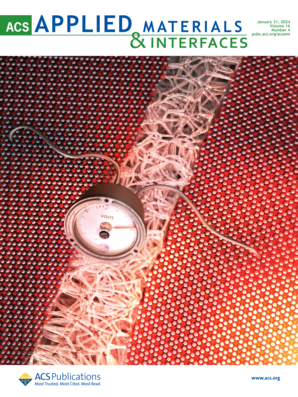聚乙二醇化核壳x射线荧光纳米颗粒造影剂的设计与生物分布
IF 8.3
2区 材料科学
Q1 MATERIALS SCIENCE, MULTIDISCIPLINARY
引用次数: 0
摘要
巨噬细胞对纳米粒子(NP)的摄取及其在肝脏和脾脏等不想要的器官中的积聚是将 NP 有效输送到目标组织进行生物成像和治疗的主要障碍。聚乙二醇(PEG)的表面功能化已被证明是限制 NP 封存的一种有前途的策略,但其在生理条件下的纵向稳定性以及对 NP 生物分布的影响尚未通过体内定量方法进行研究。X 射线荧光 (XRF) 成像已被用于无创绘制专门设计的钼基造影剂的体内生物分布图,具有亚毫米分辨率、元素特异性和高穿透深度。在本研究中,我们设计了一种逐步分层合成 NP 的方法,利用全身 XRF 成像研究了硅包覆钼基造影剂上化学吸附和物理吸附 PEG 对其体内生物分布的影响。体内定量比较研究表明,物理吸附 PEG(1.5 kDa)不会对生物分布产生实质性影响,而 mPEG-Si(6-9 个 PEG 单位)的化学吸附途径则会导致生物分布发生显著的宏观变化,从而减少肝脏对 NP 的吸收。此外,研究结果还强调了脾脏在补偿肝脏有限的螯合作用方面所起的主要作用,这一点通过在二氧化硅外壳掺入荧光团的多尺度成像方法在显微镜下得到了验证。这些发现证明了 XRF 成像在快速评估表面功能化造影剂与全身体内定量药代动力学研究中的重要作用,为制定识别和绕过不希望的 NP 吸收的策略奠定了基础。本文章由计算机程序翻译,如有差异,请以英文原文为准。

Design and Biodistribution of PEGylated Core–Shell X-ray Fluorescent Nanoparticle Contrast Agents
Nanoparticle (NP) uptake by macrophages and their accumulation in undesired organs such as the liver and spleen constitute a major barrier to the effective delivery of NPs to targeted tissues for bioimaging and therapeutics. Surface functionalization with polyethylene glycol (PEG) has been demonstrated to be a promising strategy to limit NP sequestration, although its longitudinal stability under physiological conditions and impact on the NP biodistribution have not been investigated with an in vivo quantitative approach. X-ray fluorescence (XRF) imaging has been employed to noninvasively map the in vivo biodistribution of purposely designed molybdenum-based contrast agents, leading to submillimeter resolution, elemental specificity, and high penetration depth. In the present work, we design a stepwise layering approach for NP synthesis to investigate the role of chemisorbed and physisorbed PEG on silica-coated molybdenum-based contrast agents in affecting their in vivo biodistribution, using whole-body XRF imaging. Comparative quantitative in vivo studies indicated that physisorbed PEG (1.5 kDa) did not substantially affect the biodistribution, while the chemisorption route with mPEG-Si (6–9 PEG units) led to significant macroscopic variations in the biodistribution, leading to a reduction in NP uptake by the liver. Furthermore, the results highlighted the major role of the spleen in compensating for the limited sequestration by the liver, microscopically validated with a multiscale imaging approach with fluorophore doping of the silica shell. These findings demonstrated the promising role of XRF imaging for the rapid assessment of surface-functionalized contrast agents with whole-body in vivo quantitative pharmacokinetic studies, establishing the groundwork for developing strategies to identify and bypass undesired NP uptake.
求助全文
通过发布文献求助,成功后即可免费获取论文全文。
去求助
来源期刊

ACS Applied Materials & Interfaces
工程技术-材料科学:综合
CiteScore
16.00
自引率
6.30%
发文量
4978
审稿时长
1.8 months
期刊介绍:
ACS Applied Materials & Interfaces is a leading interdisciplinary journal that brings together chemists, engineers, physicists, and biologists to explore the development and utilization of newly-discovered materials and interfacial processes for specific applications. Our journal has experienced remarkable growth since its establishment in 2009, both in terms of the number of articles published and the impact of the research showcased. We are proud to foster a truly global community, with the majority of published articles originating from outside the United States, reflecting the rapid growth of applied research worldwide.
 求助内容:
求助内容: 应助结果提醒方式:
应助结果提醒方式:


